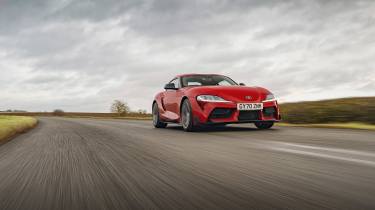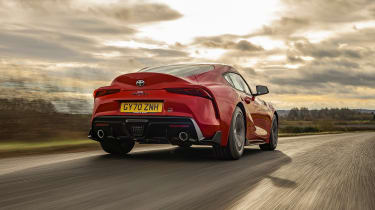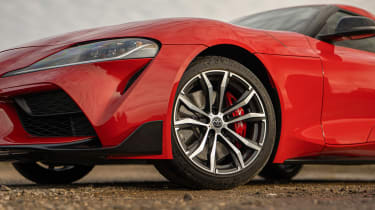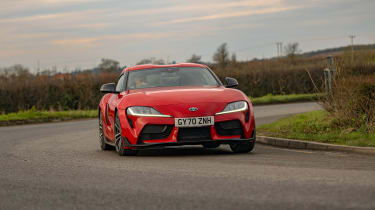Toyota Supra 2.0 2021 review – a tempting 718 Cayman alternative?
Does Toyota’s new four-cylinder Supra have the edge on its heavier, more expensive six-cylinder sibling?
It’s fair to say that the fifth generation Supra, launched over a year ago now, didn’t instantly achieve icon status. It kept the classic layout of a straight-six up front and rear-wheel drive, but with underpinnings borrowed largely from the BMW Z4 it was always going to be a challenge to make it dynamically compelling.
Still, there were few complaints about the 335bhp, turbocharged BMW straight-six which gave it generous performance and a dollop of class. Now there’s a version powered by a turbocharged, four-cylinder engine – the first in Supra history – and it has the potential to be better, as well as less expensive, because it weighs 100kg less. And crucially most of that weight comes off the front axle, improving the Supra’s weight distribution to the sought-after 50:50 ideal.
Engine, gearbox and 0-60mph time
The 1998cc BMW in-line four may be a whole litre and two cylinders down on the straight-six but it’s still a punchy engine. It makes 254bhp and 295lb ft versus the six’s 335bhp and 368lb ft, but those figures are accentuated by the lower kerb weight, of course, and it offers peak torque across a broad rev band – from 1550 to 4000rpm. There’s no manual gearbox option here either, and drive is sent to the rear wheels via the ZF 8HP eight-speed automatic gearbox. Toyota’s 0-62mph figures put the gap between the two at almost a second, the four-cylinder taking 5.2sec, the six takes 4.3sec. Both are limited to 155mph.
Technical highlights
Beneath its muscular coupe body, the Supra’s floorpan and suspension are BMW-sourced, which means MacPherson struts at the front with electrically-assisted power steering, and a five-link rear axle. Spring and damper rates are tweaked to suit the four-cylinder version’s lower mass and altered distribution, and it gets the same adaptive elements as the straight-six model, including switchable damping and an electronically controlled limited slip differential to assist and manage traction. The major divergence – and the only obvious visual differentiator – is the fitment of 18-inch, rather than 19-inch alloys, shod with taller sidewalled tyres of the same width: 255 section at the front and 275 at the rear.
What’s it like to drive?
Push the start button and the sound that filters through the bulkhead isn’t the smooth burr of the straight-six, but neither is it the monotone bark of an in-line four. This is thanks to sound augmentation via the speakers, disguising the engine’s expected voice and creating a rather ambiguous note. There’s plenty of low-rev pick up and the engine revs through to the redline smoothly and in a very refined way. It’s quick enough to feel sporty and the auto box is slick.
More reviews
Group tests
In-depth reviews
Long term tests
Reviews
Once rolling, one of the first things that strikes you is how much more rounded the ride is and how much better the rear axle in particular copes with sharp bumps. This is in part down to the taller tyre sidewalls, and so too is the welcome slowing down of the steering response just off-centre. In the wet, fast steering and limited low-speed traction makes the 2-litre Supra require fast reactions when at the limit. In fact it seems to gain grip and traction with speed and proves remarkably poised and comfortable on a bit of opposite lock.
So, the four-cylinder car feels better at low speed, but it too is well balanced and biddable. It feels a little less precise and engaging when pushed, but there’s decent grip and pressing the Sport button firms up the dampers usefully, gives the engine more voice and adds weight to the steering. However, there’s not much feel through the wheel to work with, and while the chassis is responsive there’s a rather elastic quality to its feel. Add in an engine that seems a bit remote and a gearbox that doesn’t give quite the directness and instant, undefeatable seamlessness of a good DSG and the whole experience of driving briskly lacks connection and detail.
Price and rivals
At just shy of £46k, the four cylinder Supra is a good £8k less than the six cylinder model. If comfort is more important than pace, you get pretty much the same looks and the ‘four’ is refined and still pretty quick. However, if you were hoping for a more dynamic coupe, thanks to better weight distribution and slightly less mass, the lack of feedback and engagement will probably have you considering its rivals. There are only a few but dynamically they’re rather talented and engaging.
The Alpine A110 costs a little more (£48k), has similar horsepower and is a lightweight, mid-engined car of remarkable dynamic character and ability. Then there’s the base Porsche Cayman 718 which costs slightly less (£44k), but is also a seriously capable mid-engined, four-cylinder, sports car. OK, the Porsche flat-four isn’t well liked but it does deliver almost 300bhp and the Cayman puts it to brilliant use.






